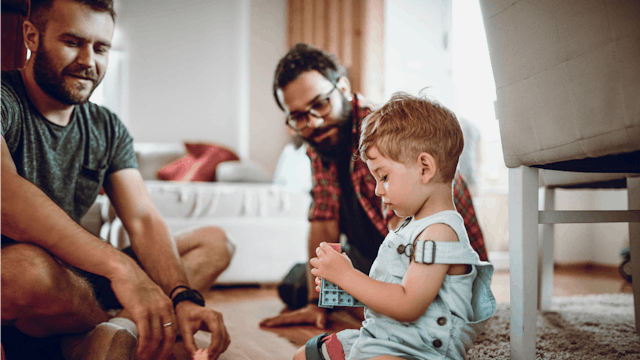LGBTQ Families Are On The Rise

According to a 2018 Gallup poll, there are 15.9 million LGBTQ Americans. This makes up about 4.5% of the U.S. population. But of these numbers 6.1 million of these LGBTQ identified people are ages 18-35. They are Millennials.
A LGBTQ Family Building Survey done by The Family Equality Council reports that 63% of these queer Millennials are planning to add to their existing family or start a family through one of many options now available to queer folks and couples.
This is not to say that older LGBTQ people don’t have children. We do. I am a Gen Xer and my kids were conceived via anonymous frozen sperm and my partner’s eggs. But the more you talk to older LGBTQ folks, you will learn that there were not a lot of opportunities when trying to create families, nor was there a lot of information or resources to help. Many families were blended because kids were born via intercourse before one spouse came out as queer or transgender. The equal rights movement is still slow and there are many places that deny LGBTQ people from adopting or fostering children. But the places to adopt or conceive were limited at best for older LGBTQ individuals or couples.
If a queer couple was able to adopt or conceive a child through a donor sperm, donor egg and/or surrogate, the rights of the second parent or non-biological parent were often not recognized. I am the non-gestational and non-bio parent to my three children. My kids were born before the Supreme Court passed the Marriage Equality Act in 2015. I live in a state that allowed gay marriage and was married to my partner when my daughter and then twins were born; all of this allowed me to be listed on the birth certificate as my children’s second parent.
However, this status would have been null and void in all of the states and countries that did not recognize gay marriage. In most places, I didn’t have any more rights to my children than a stranger would have. Because of this, I went through the legal process of adopting all three of my kids. It was a kick in the teeth to go through the process of being fingerprinted for criminal background checks. I shouldn’t have had to ask to file a motion to waive a visit from a social worker to come into my home to validate my ability to parent. The second adoption took time and money away from my family to prove I was not only a fit person, but that I was allowed to legally have children. This was all because I am queer and wanted to be a parent.
With the passing of the Marriage Equality Act and as more LGBTQ people are coming out at earlier ages, there is a greater sense of security, justified entitlement, and excitement for queer Millennials to grow families.
And the gap between the number of non-LBGTQ people and LGBTQ people who have kids or are looking to start families is shrinking too. The Family Building Survey reports: “48% of LGBTQ Millennials are actively planning to grow their families, compared to 55% of non-LGBTQ Millennials, a gap that has narrowed significantly in comparison to older generations.” In 2013, the Pew Research Center reported that 74% of non-LGBTQ identified adults were parents, while only 35% of LGBTQ adults had children.
As the population shifts to becoming queerer with more queer parents, the way we think about parenting needs to change too. Businesses, medical practices, adoption agencies, welfare systems, and assisted reproductive facilities need to adjust policy and procedures to be more inclusive.
Medical students are pushing for more training when it comes to LGBTQ topics and patients. Medical spaces are either scrambling or are far behind in creating affirming and safe places for queer patients. Too many people are not educated on the difference between gender and sex and sexuality. Because of this, people, even doctors, fall into biased and heteronormative beliefs. Binary pronouns are assumed for people based on their gender expression. Pregnant woman are assumed to have a male partner if not husband. And people assume men can’t have babies; transgender men can and have had babies.
But we are forced to fight for space and representation in both images and languages when queer people try to become parents. The desire to have a child transcends gender and sexualities, yet LGBTQ individuals and couples have to justify that desire or prove our worth as humans just because we are not the “normal” type of family.
People need to let go of the idea that only straight people want kids or that only straight people make good parents. Kids do not need a mother and father in the house to be well adjusted and happy kids. In fact, studies have shown that there is not a negative impact to kids raised by gay parents. They actually thrive.
I want to see companies that sell baby and kid products market to me, a queer nonbinary parent who has three kids and little time for mass produced shit that tries to fit me into a binary and gender conforming box. I am not asking for specific products, per se, I am asking for products that already exist to be sold in ways that include all people. Because we have money too.
I want to walk into an OB-GYN office and see photos of same-sex couples, pregnant men, and forms that ask for my preferred pronouns.
I want people to know that there is a new normal emerging. It might still be love, marriage, and a baby carriage, but now with more rainbows and diversity.
This article was originally published on